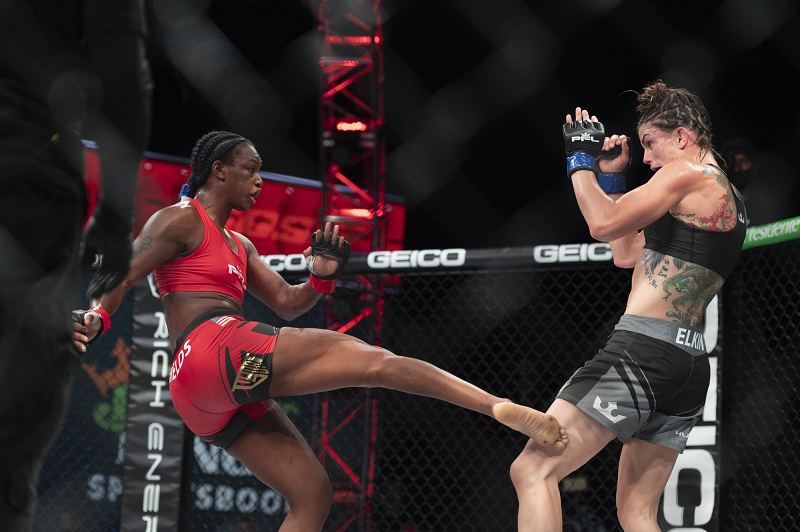
By Andy Marston
Recently valued at $10 billion, the Ultimate Fighting Championship (UFC) is a behemoth. Since its establishment in 1993, the competition has become synonymous with Mixed Martial Arts (MMA). Under Dana White, the UFC has either acquired rivals or forced them into submission.
There is, however, a challenger that the UFC has failed to hush.
In just three years, the Professional Fighters League (PFL) already has 25% of the audience of the UFC. While still a long way from being able to compete pound for pound, the PFL believes it has the makings to become the number one challenger to the UFC’s dominance.
Here are some of the reasons why, and what lessons other teams and leagues can learn from the PFL.
Lesson 1: Simplify the format
The PFL has re-imagined MMA, featuring elite athletes across six-weight classes who each have two fights during the regular season. Unlike the UFC, the PFL presents MMA in a format where individuals compete in a true sports format with play-offs and a championship, ensuring every fight counts.
This strategy can also be adopted in other sports where a league structure does not already exist. Take the Racing League, starting this month – the horse racing competition will see teams compete for points that are distributed in a similar fashion to Formula 1’s constructors’ championship.
Lesson 2: Increase access
The PFL is broadcasted live on ESPN 2. This is unique for a combat sport, which often uses a pay-per-view (PPV) model; however, it goes a long way in explaining how the league already has a sizeable audience.

While the UFC has a contract to broadcast fights with ESPN, its premium fights are PPV only. This minimizes the potential audience size and can be limiting for a sport, or league, that is looking to scale.
Visibility is a major reason why DAZN, who recently acquired the exclusive rights to stream the UEFA Women’s Champions League, is going to offer a majority of its matches free on its YouTube channel. The increased accessibility of women’s football develops greater awareness and demand.
Lesson 3: Equal representation
The PFL offers an equal US$1m prize in each weight class for men and women. This has led to a greater buy-in from fighters who respect the transparency and gender equality. As a result, the league has been able to attract fighters of the calibre of Rory MacDonald.
In 2011, Dana White was asked whether he could imagine seeing women in the UFC; he responded with a sharp “never.” He has since been forced to eat his words, with UFC’s modern landscape unimaginable without the women’s divisions and Ronda Rousey now one of the most marketable faces and dominant forces in the UFC.
New competitions, such as The Hundred, cricket’s new innovative short-form competition, are focused on equality. The tournament launched with a standalone women’s fixture and the England & Wales Cricket Board (ECB) will also offer equal prize money for the men’s and women’s winners.
Lesson 4: Embrace the data
Few in the sports industry have adopted data integration to the extent of the PFL, with fights taking place inside a ‘SmartCage’ with broadcasts overflowing with metrics such as punch speed and heart rate tracking.
The data provided helps to illustrate the quality of a fighters’ performance. It also provides commercial opportunities, particularly in attracting betting partners. As part of a recent deal agreed with DraftKings, betting odds will be integrated into broadcasts.
Other leagues have also sought to integrate biometric data into their broadcast proposition. The PGA Tour have shown live Whoop heart rates from players such as Rory McIlroy and Justin Thomas. There is also huge potential for leagues to use data to improve their performance, as Ospreys and Hull City have shown.
Lesson 5: Profile the athlete
The PFL has built up a strong narrative around the fighters. Compared to the UFC, which only focuses on a select few top stars, the compactness of the PFL means it can build a profile around each fighter.
With a family to provide for, @KaylaH‘s drive to be the best continues #PFLPlayoffs pic.twitter.com/RngrijkuDT
— PFL (@PFLMMA) August 19, 2021
Through its docuseries on Netflix, Formula 1 has managed to create a narrative around each of its drivers. In return, F1 has gained huge loyalty from a new generation of fans. A recent study by Nielsen Sports cited Drive to Survive as a key reason for the sport’s increasing popularity among people aged 16 to 35, who accounted for 77% of F1’s audience growth in 2020. This personal connection is absolutely key for any sports organisations looking to grow in 2021.
Takeaways and opportunities
One of the clearest indicators of the PFL’s success to date is the impressive array of commercial partners it has attracted. While the PFL and UFC share partners such as ESPN, Anheuser-Busch InBev, DraftKings and Socios, they have also attracted household names that don’t associate with the UFC, such as Acronis and Bose.
Another pertinent example is SailGP, which was co-founded by Larry Ellison, founder of Oracle, and has attracted commercial partners such as Rolex, Cognizant and Kuehne+Nagel. Ultimately, brands are attracted by rights holders that are willing to disrupt the status quo and do things differently – for the better.
I’m a huge fan of the My First Million podcast and in their recent interview with Scott Belsky, Chief Product Officer at Adobe, he said, “When everyone says interesting is dead, it means that something is being born.”
To apply this to sport, which is still struggling to recover from the pandemic, there is an opportunity for challengers to disrupt the status quo and do things differently – for the better.
The PFL is one of many organisations that is demonstrating how.
Andy Marston is an Insights Manager at CSM Sport & Entertainment www.csm.com

